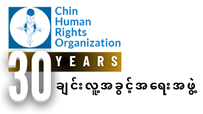Rhododendron Publication – Volume VII.No.I. January-February 2004
Volume VII.No.I. January-February 2004 Rhododendron News Volume VII. No. I. January-February 2004 www.chro.org TABLE OF CONTENTS Human Rights Over 200 Household Forced to Work in Road Construction Villagers Forced to Work In Rih Area Villagers Forced as Porters Burmese Army Robed Chin Farmers Burmese Army Extort Money from Villagers
